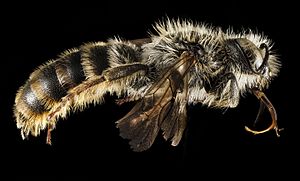Osmia rufohirta
| Osmia rufohirta | ||||||||||||
|---|---|---|---|---|---|---|---|---|---|---|---|---|

Osmia rufohirta |
||||||||||||
| Systematics | ||||||||||||
|
||||||||||||
| Scientific name | ||||||||||||
| Osmia rufohirta | ||||||||||||
| Latreille , 1811 |
Osmia rufohirta is an endangered and moderately common mason bee . In Germany and Switzerland it is on the red list 3 for endangered species. The German name is not uniform. There are the terms slim, snail-shell mason bee or red-bristle mason bee .
features
Osmia rufohirta grows to 9 to 13 mm and lives solitary. The female is colored reddish through the hair on the whole body and the male only at the rear end.
Occurrence
It occurs all over Germany with a focus on the southern area. It prefers dry, chalky places such as fallow land, open warm heathland and disused quarries and vineyards, rocky slopes, dunes and road embankments as living space.
Way of life
The flight time ranges from mid-May to early July. After mating, the female looks for small abandoned snail shells in which to lay her eggs. To do this, she checks whether the snail shell can be moved and only creates a single egg chamber there. To do this, she lines it with a mortar made from saliva and plant parts and sticks it on the outside. A pollen-nectar mixture is then deposited in the snail shell and an egg is placed on it. Then the snail shell is closed with stones, chunks of earth and the plant mortar and rolled away. The overwintering takes place as an imago in the cocoon in the snail shell, where it then hatches in the next spring.
It does not depend on any particular pollen for food, but prefers the common horn clover (Lotus corniculatus) , the horseshoe clover (Hippocrepis comosa) , and the fodder esparsette (Onobrychis viciifolia) .
Similar species
The female is very similar to O. aurulenta , but is built much more slender and has a relatively smaller head. Because of the elongated and clearly pointed, orange-red haired abdomen, the male is easily recognizable.
Web links
- Osmia rufohirta at eol.org/pages
- Photos at naturbildarchiv-guenter.de
Individual evidence
- ↑ Osmia rufohirta at wildbiene.com, accessed on May 28, 2020.
- ↑ Information system for the Baden-Württemberg target species concept (April 2009)
- ↑ blogs.ethz.ch Palaearctic Osmiine Bees
- ↑ Osmia rufohirta at wildbienenwelt.de, accessed on May 28, 2020.
- ↑ Snail-shell mason bee at bienenwanderung.de, accessed on May 28, 2020.